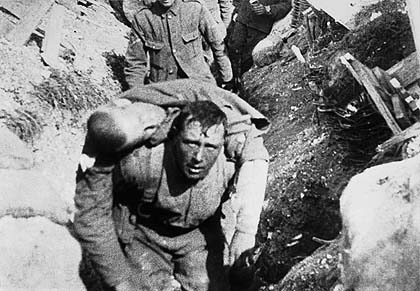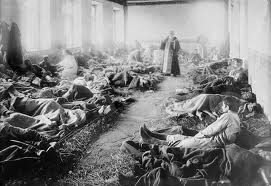On the Battlefield, Conditions for the Wounded Are Appalling.
Little Doctors Can Do.
Special to The Great War Project
(8-12 January) A warning — this report contains disturbing information and may be too graphic for some readers.
A soldier lies wounded on the battlefield. Conditions are bad enough for the unwounded man. But “those who became casualties suffered appallingly,” writes historian Max Hastings.
An example from one German soldier: “Among a bunch of corpses lay three wounded Frenchmen. One man had both legs shattered; the second’s stomach was torn open; the third had tried to shoot himself until one of our chaps took away his gun. He fired twice at his own head to escape pain, but aimed clumsily, a little too high.
“The skullcap was uplifted and he moaned in a fashion to melt the heart.
“Another man lay apparently dead, but with one leg still twitching like that of a partridge that is unable to die.
“Awful!”
Military medicine remains primitive, advancing according to Hastings “less than many other branches of science.”
Antibiotics are yet to be discovered. In their absence, Hastings observes…
“gangrene remained a massive killer, its contribution increased by the days of delay many men endured before their wounds were properly treated.”
“Patients often deluded themselves that they were recovering because their pain receded. In truth, however, they had merely acquired the numbness and pallor that signified imminent death.
“Survival required extraordinary luck.”
And even if wounded soldiers are lucky enough to reach a field hospital and are still alive, those too are in appalling conditions. One French soldier visiting a severely wounded comrade in a field hospital “found eighty men lying on straw in a sugar factory, still dressed in their mud-soaked uniforms,” writes Hastings.
The hospital has one bed.
Hastings reports one incident where a fifteen car ambulance train carrying 500 wounded men follows a rail that leads to a blown bridge across the River Marne in France. Thirteen carriages plunge headlong into the river.
When wounded men do encounter doctors in a field hospital, there is often little the doctors can do. One French army medical officer describes his own pathetic efforts to treat one wounded man. “His face, with a broken jaw, is no more than a bloody mess. Having removed some fragments from his mouth, we managed to lower a tube into the esophagus through which we pass a sort of enema, some water and then some coffee.”
At this particular hospital, there is often insufficient water even to wash the mud from the orderly’s hands. Blood transfusions are practically unheard of. In any case conditions are too filthy to carry out transfusions.
Most of the wounded are suffering from shock, but there is nothing that the medical personnel can do to treat shock.
Medical personnel are also required to bury the dead, the state of whose bodies are too terrible to describe here.
This proves true for all those fighting on the Western and Eastern fronts, French, German, British, and Russian alike. None of the hundreds of thousands of wounded are spared.



The conditions are appalling and it doesn’t sound much better than what soldiers experienced during the Civil War during the 1860s and yet medical science had been making great strides for several decades.